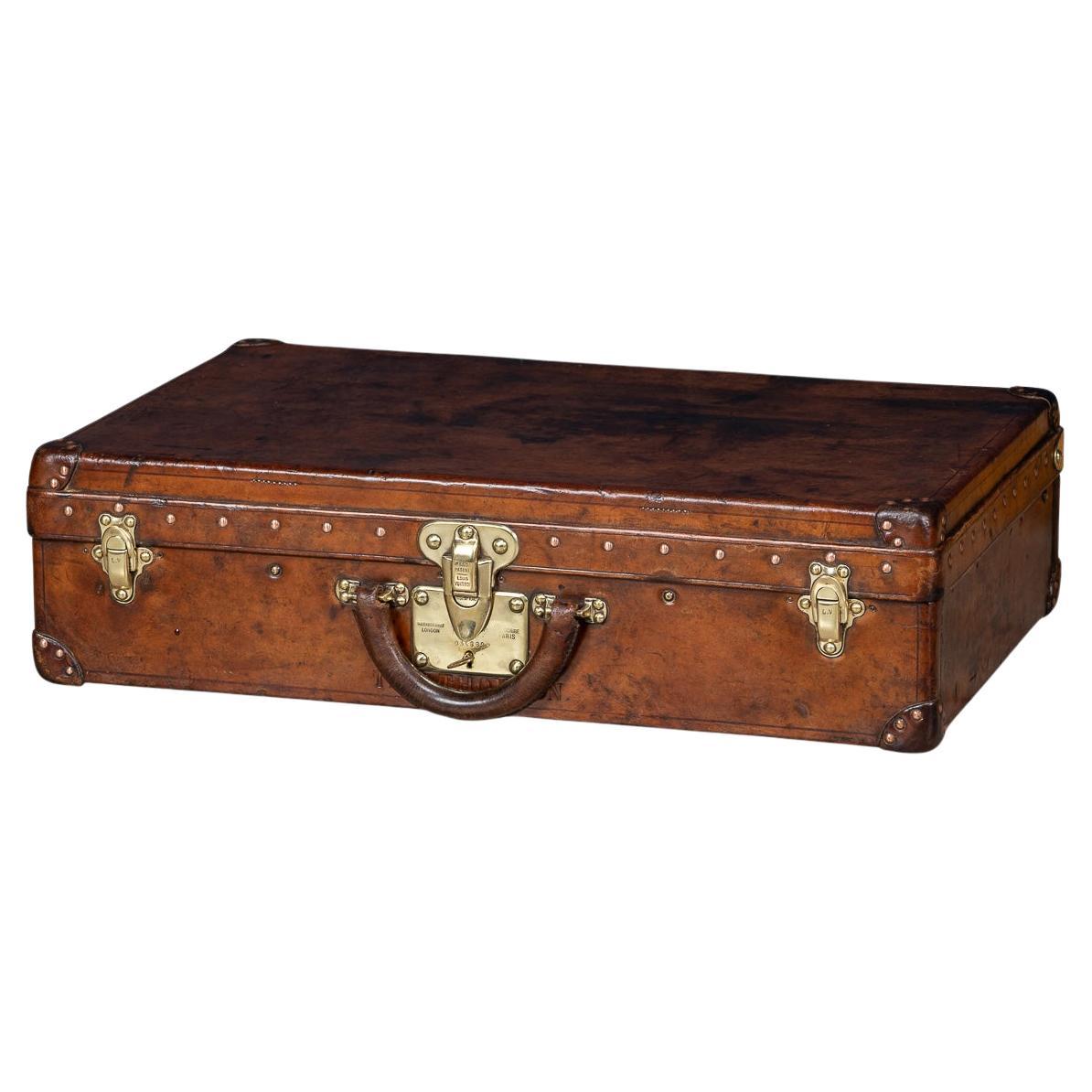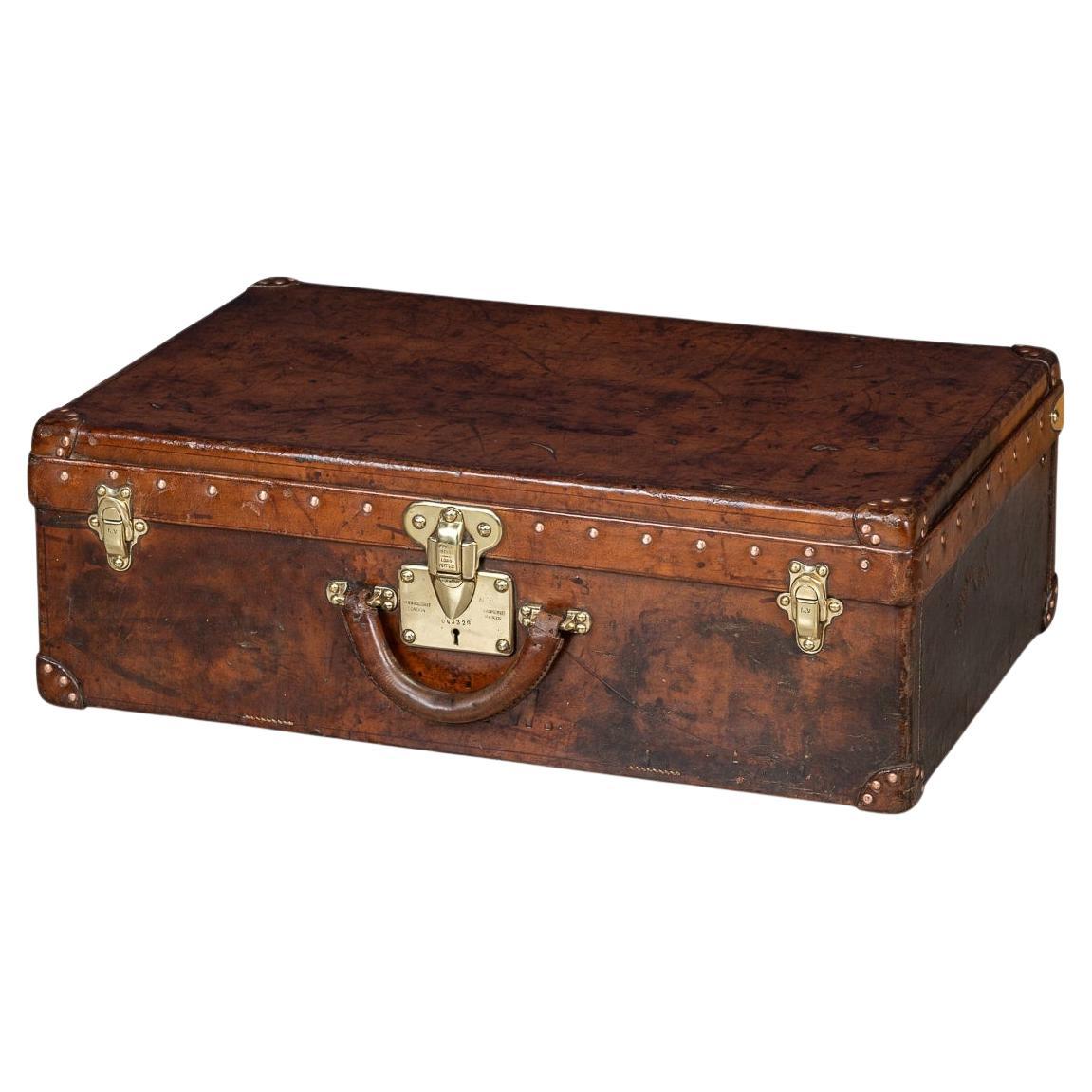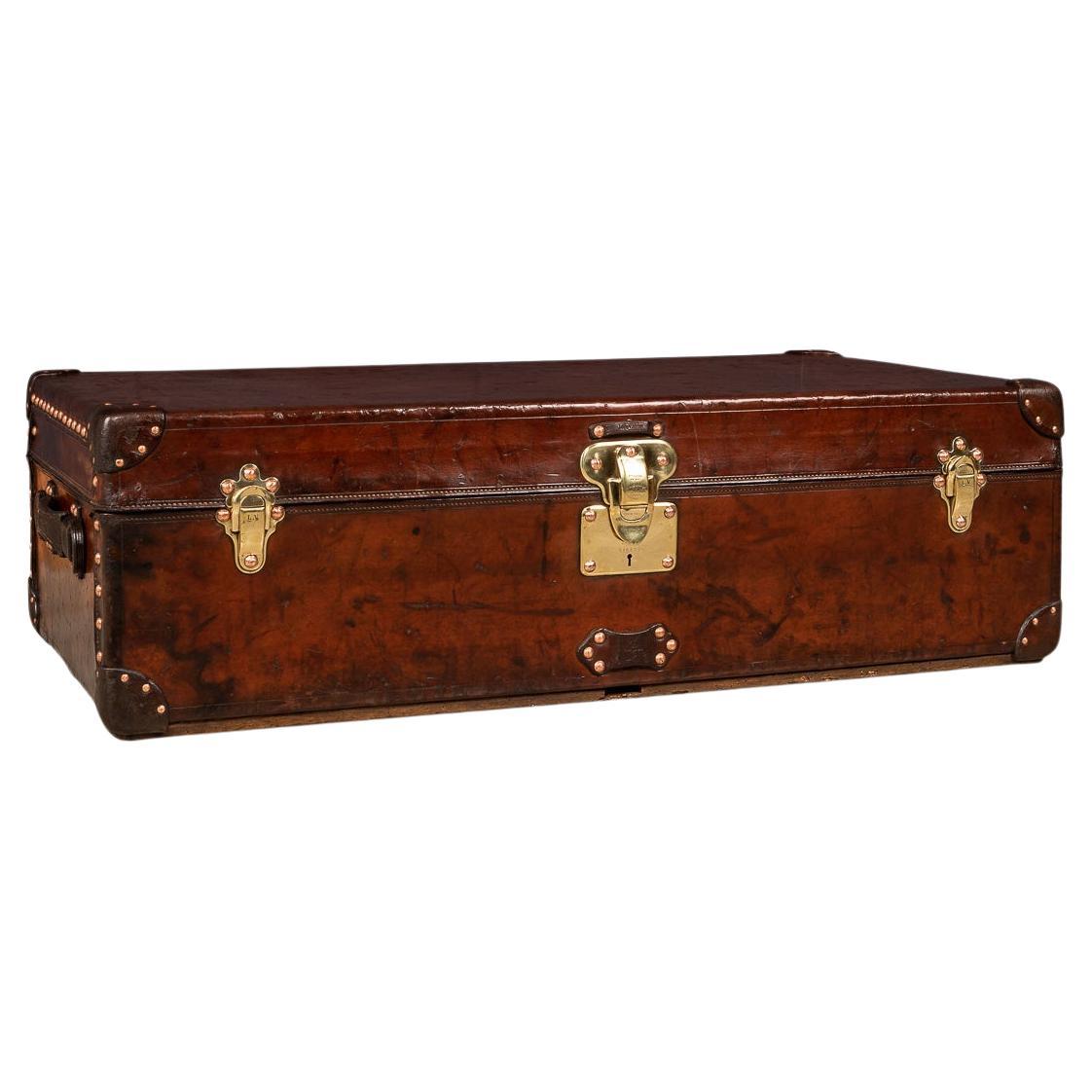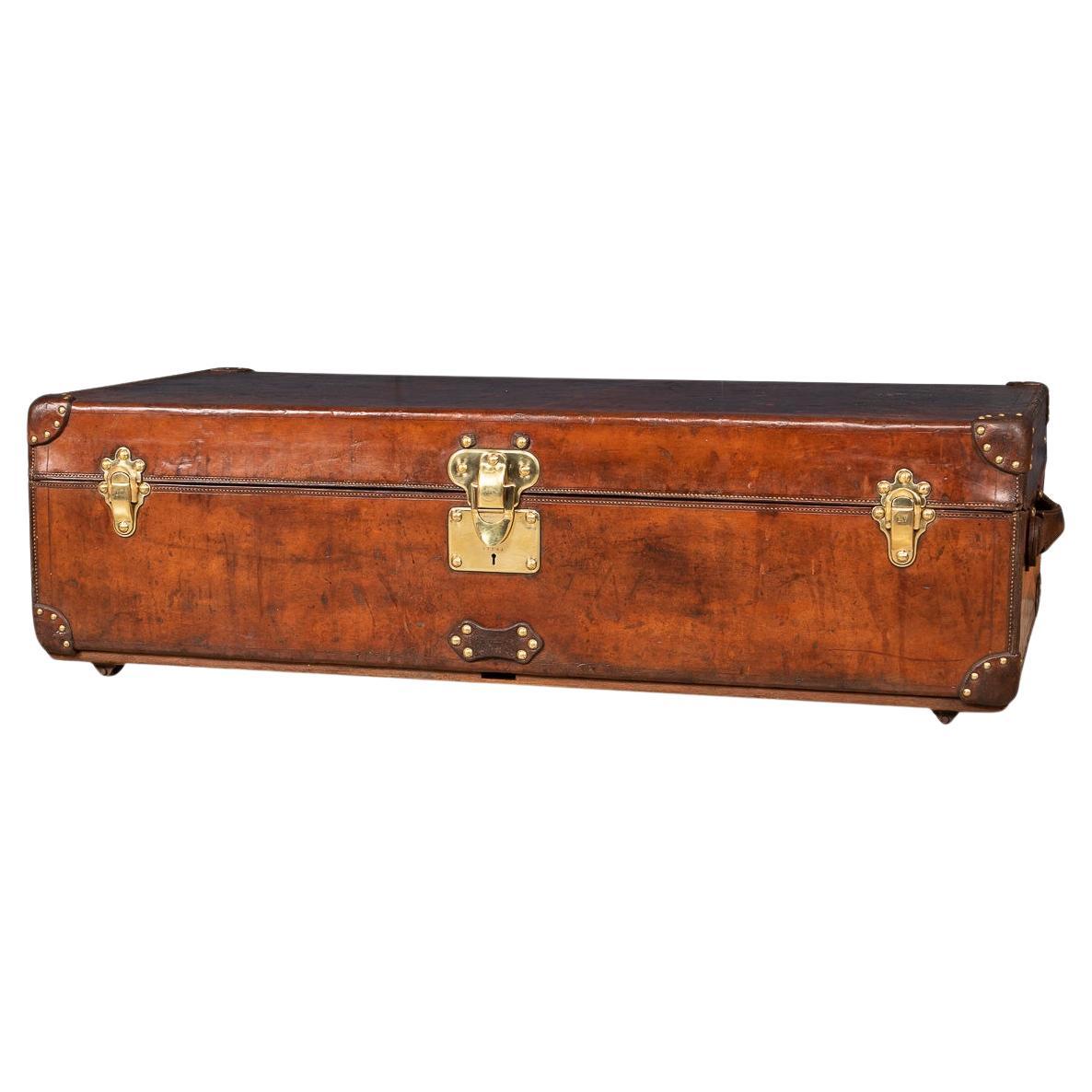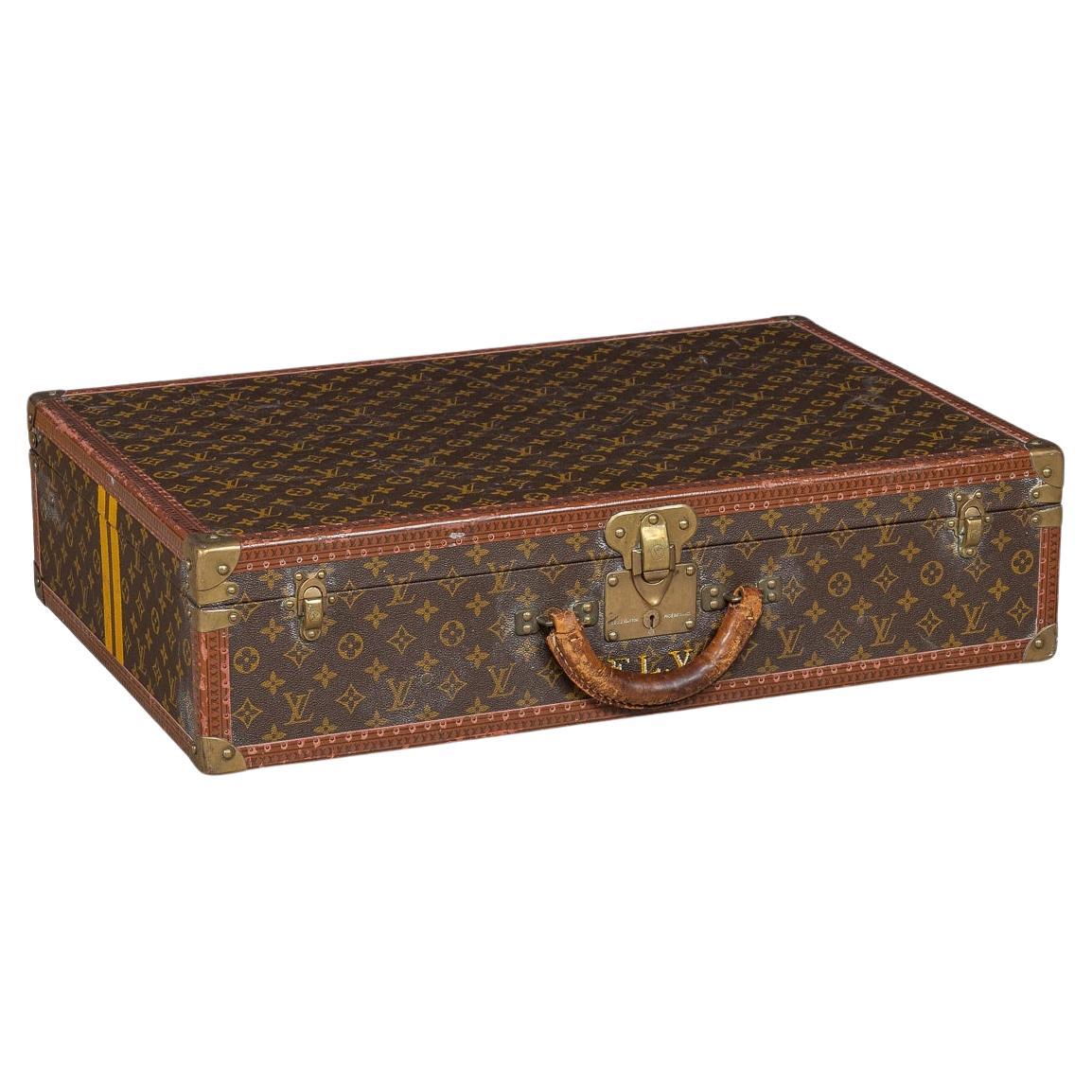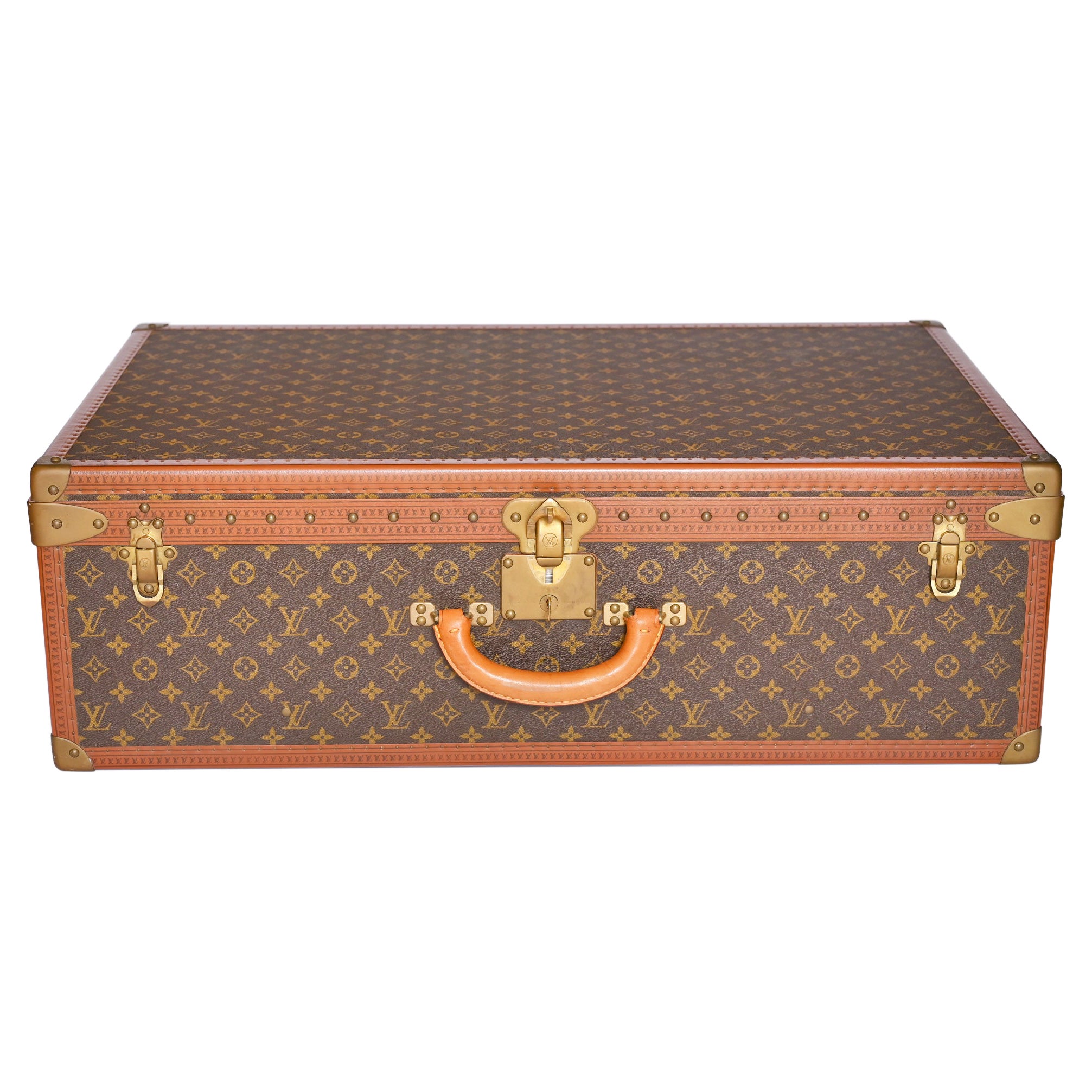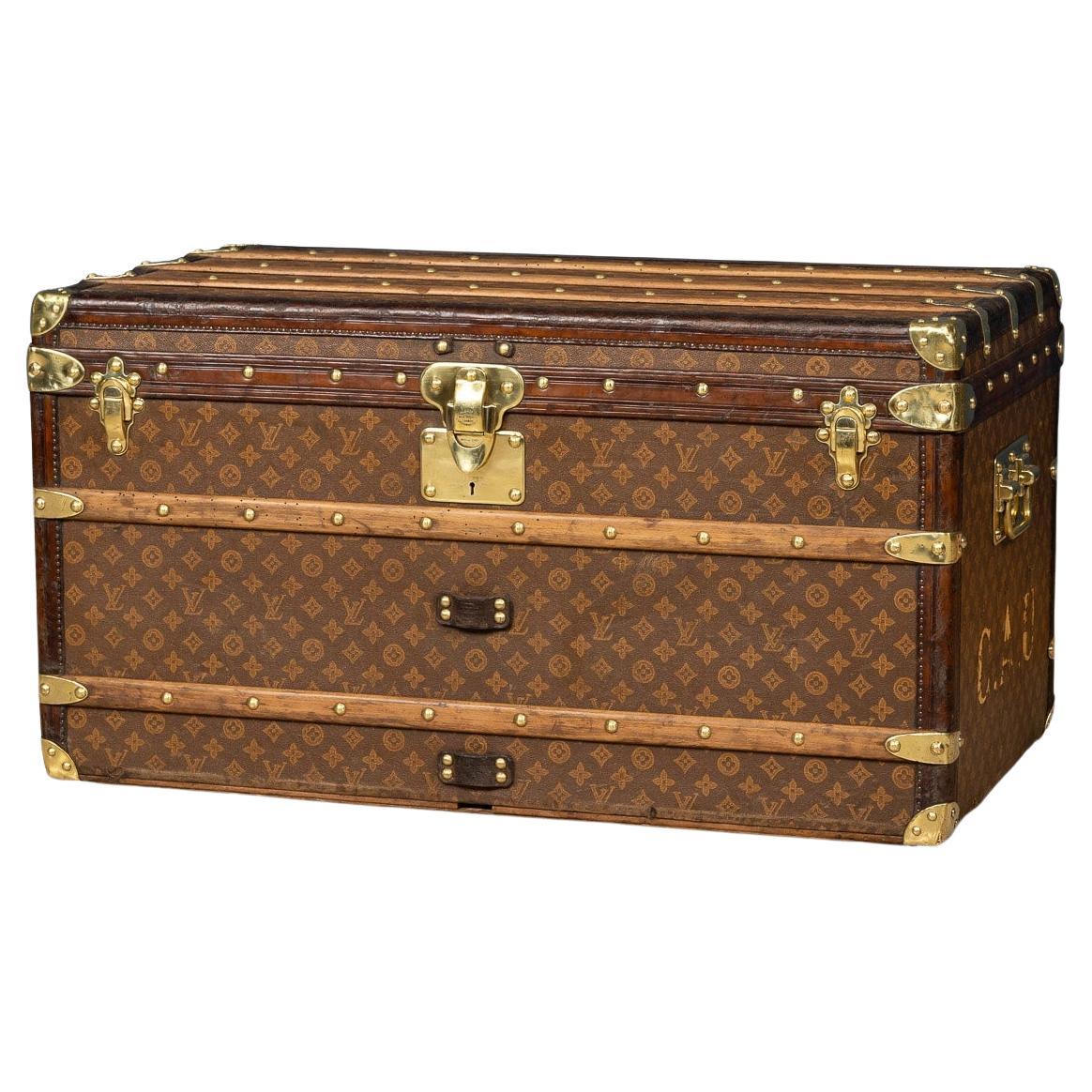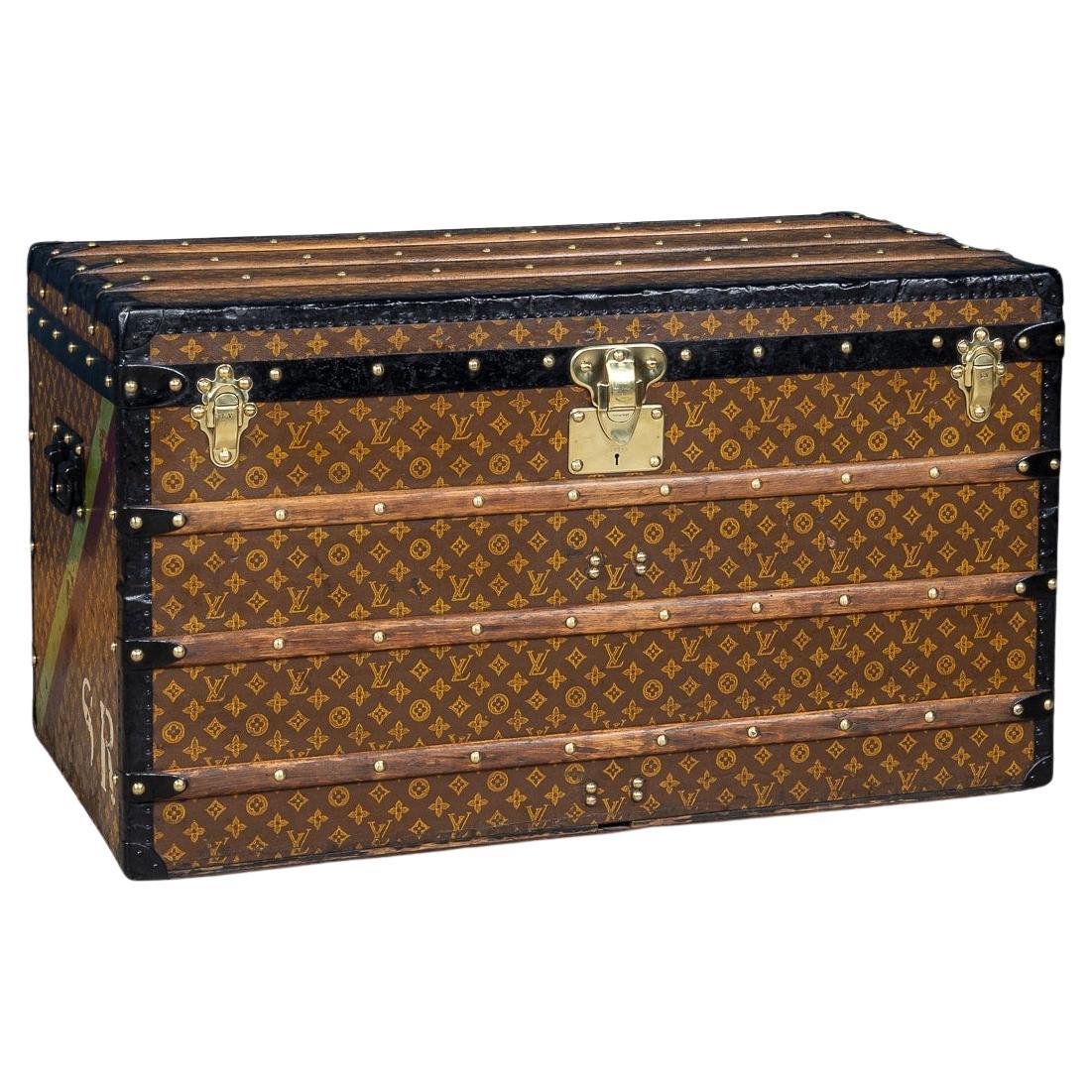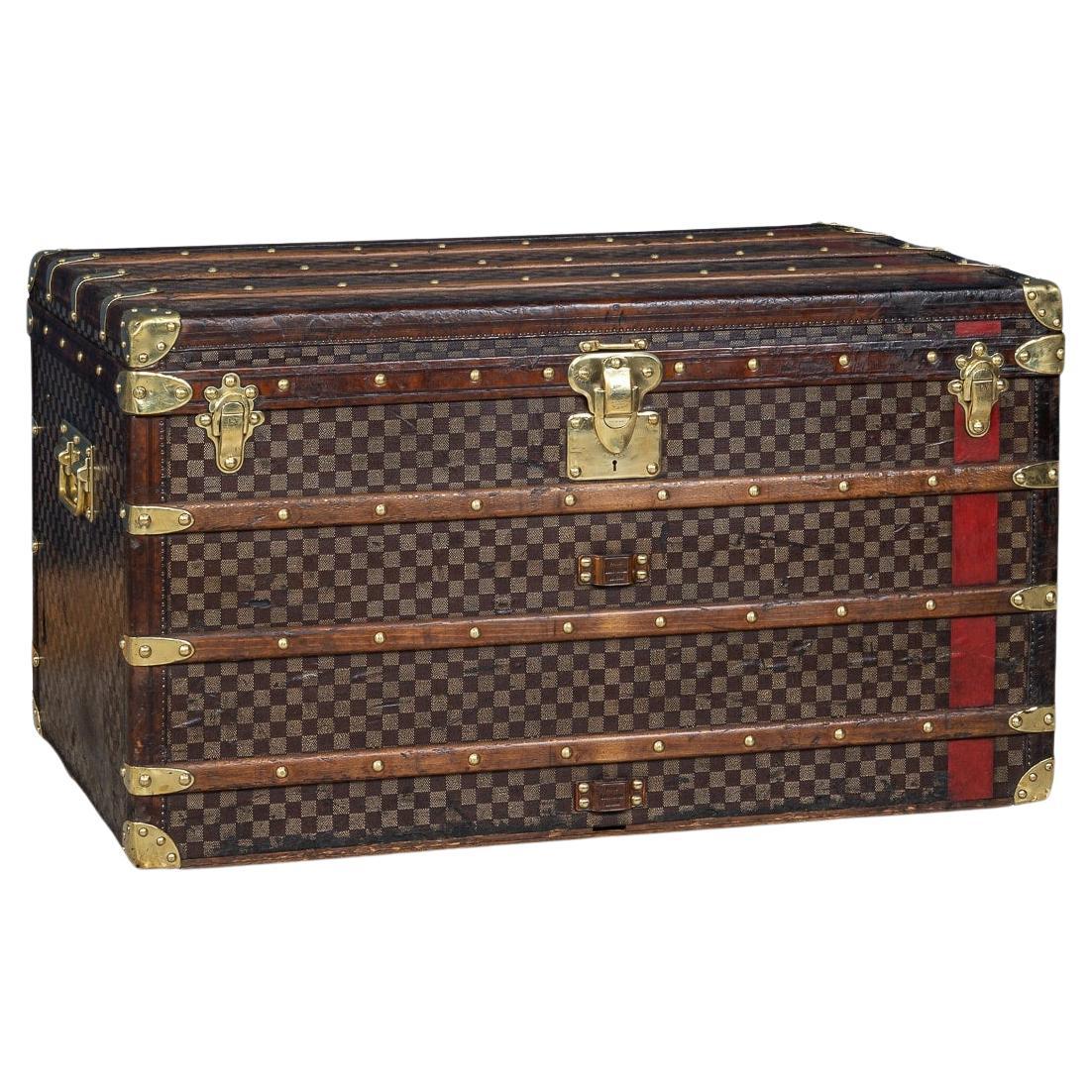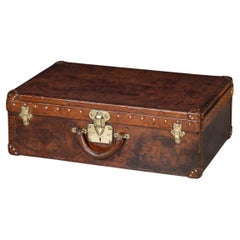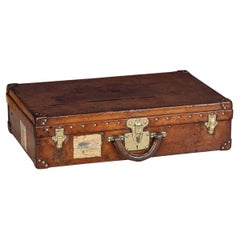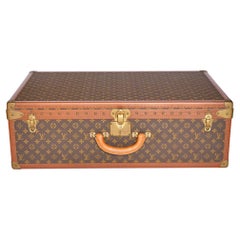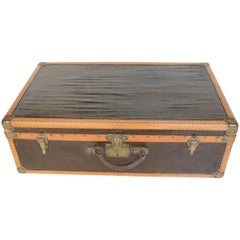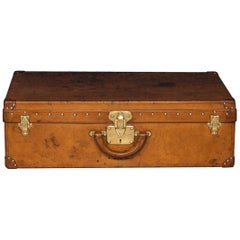
20th Century Louis Vuitton Suitcase in Natural Cow Hide, France, circa 1900
View Similar Items
20th Century Louis Vuitton Suitcase in Natural Cow Hide, France, circa 1900
About the Item
- Creator:Louis Vuitton (Maker)
- Dimensions:Height: 8.67 in (22 cm)Width: 28.35 in (72 cm)Depth: 17.72 in (45 cm)
- Materials and Techniques:
- Place of Origin:
- Period:
- Date of Manufacture:circa 1900
- Condition:Wear consistent with age and use. Minor fading. In Good Condition - No damage, just general wear and some staining on the leather.
- Seller Location:Royal Tunbridge Wells, GB
- Reference Number:Seller: A60481stDibs: LU1348216078952
Louis Vuitton
The story behind iconic luxury brand Louis Vuitton — best known for its esteemed handbags, crossbody bags, leather goods, ready-to-wear clothing and more — is one of craft and innovation in the worlds of fashion, jewelry and furniture.
The company’s modest origins can be traced back to when its founder, Louis Vuitton (1821–92), wishing to free himself from the conventional lifestyle in his provincial French city of Anchay as well as a difficult stepmother, left in the early 1830s to make a new life in Paris. The young Vuitton was 13 at the time and would need to travel on foot to get to the capital, which was hundreds of miles away. With stops along the way to make money so that he could forge ahead, the journey took a couple of years, but reward was close at hand.
When he arrived in Paris, Vuitton made a living with his hands. He toiled as a box maker and packer for more than a decade and built relationships with royals and members of the upper class while working for the empress of France, Eugenie de Montijo. In 1854, Vuitton launched his namesake company. The craftsman opened a humble workshop on rue Neuve des Capucines and advertised his services with a small poster that read: “Securely packs the most fragile objects. Specializing in packing fashions.”
Long before his brand would become known globally for its exemplary top-handle bags and stylish totes, Vuitton produced stackable and rectangular trunks. The most common trunks of the era were round, which weren’t ideal for toting and storing. In 1858, Vuitton debuted his lightweight, handcrafted canvas trunks, which were sturdy, rugged and equipped with convenient compartments. Travel’s popularity broadened in the late 19th century, and Vuitton’s trunks could easily be packed into train cars and ships — upright trunks meant hanging wardrobe storage that would allow his clients to transport their sophisticated garments without worry. Demand increased and the company grew. When Louis Vuitton died in 1892, control of the luxury house was passed onto his only son, Georges Vuitton.
In 1914, a Louis Vuitton store opened at 70 Champs-Élysées. The largest travel-goods store in the world at the time, it became the company’s flagship.
The Louis Vuitton brand embodies all the attributes of luxury, from the craftsmanship, exclusivity and relevance to heritage. It’s only appropriate that it boasts one of the most recognizable insignias — the imaginative interlocking of letters and fleurettes — in the fashion world. The famous LV monogram was first used in 1896 as part of an initiative by Georges to prevent counterfeiting of his coveted new line of travel trunks. It’s one of the earliest examples of fashion branding.
The LV monogram would soon appear on everything from bags and various fashion accessories to alligator-skin champagne cases, from stylish apparel and earrings to teddy bears and airplane models.
On 1stDibs, the unmistakable insignia can be found on both modern and vintage Louis Vuitton shoulder bags, suitcases, original 19th-century trunks, jackets and more.
- 20th Century Louis Vuitton Suitcase In Natural Cow Hide, France c.1910By Louis VuittonLocated in Royal Tunbridge Wells, KentA highly unusual and exceptionally rare Louis Vuitton suitcase, originating from the early years of the 20th century, distinguishes itself not with the globally renowned monogram canvas but with a distinctive covering crafted from a singular piece of cowhide. This unique piece represents a special order from Louis Vuitton, showcasing the brand's historical commitment to utilising only the finest hides available. Unlike many of its counterparts, leather trunks and cases of this era often struggle to withstand the test of time, requiring regular treatments to prevent drying and disintegration. Remarkably, this particular example defies the odds, retaining the same supple quality it possessed on the day it first graced the shop floor. This suitcase belongs to Louis Vuitton's collection of "speciality materials," which encompasses a diverse range, including, but not limited to, zinc, copper, crocodile leather, and cow leather. A brief history about Louis Vuitton trunks: Louis Vuitton was born in 1821 to a farmer and milliner and came from a long-established working-class family in eastern France. Vuitton grew up understanding the effects of perseverance and a strong work ethic from watching his family. At the age of 16, he made the decision to walk 292 miles from his hometown to Paris to try and make a new life for himself. When he arrived the city was in the midst of industrialization with current modes of transportation evolving quickly allowing for longer journeys. With this came the need for sturdy travel pieces. Vuitton was taken as an apprentice for a successful box maker and packer named Monsieur Marechal. He learned to craft durable containers and how to pack them properly – a well-respected profession at the time.In 1854, years after he had mastered his craft and became well respected for it, Vuitton ventured out on his own to open a shop on Rue Neuve des Capucines. It was here that he began to establish himself as a luggage maker. Then, in 1858, Vuitton designed the first Louis Vuitton steamer trunk. At the time trunks had rounded tops to allow for water to run off but this did not allow for convenient stowage. Vuitton introduced a flat, yet waterproof, trunk that was easily stackable. The first of his trunks were outfitted with a grey canvas referred to as Trianon – it wouldn’t be until several decades later that the signature monogram would be introduced. With a burgeoning business, Vuitton moved his family and workplace to Asniere, where he employed twenty workers to craft his trunks. By 1900 he would have 100 employees, and in 1914 the company would more than double in size. After years of success, Vuitton began to experiment with the design of his luggage by introducing a new striped canvas pattern (1876) and later the still well-known Damier print (1888). The hand-painted patterns were developed to prevent counterfeits. Even in the late 1800s, Louis Vuitton was enough of a status symbol to warrant counterfeiting. In 1886, his son George invented and patented an ingenious locking system that made it impossible to pick the lock of their trunks. This lock is still used today. 1892 would prove to be a time of mourning for the family as Louis Vuitton passed...Category
20th Century French Other Trunks and Luggage
MaterialsBrass
- 20th Century Louis Vuitton Cow Hide Suitcase, France c.1920By Louis VuittonLocated in Royal Tunbridge Wells, KentA highly unusual and exceptionally rare Louis Vuitton suitcase, originating from the early years of the 20th century, distinguishes itself not with the globally renowned monogram canvas but with a distinctive covering crafted from a singular piece of cowhide. This unique piece represents a special order from Louis Vuitton, showcasing the brand's historical commitment to utilizing only the finest hides available. Unlike many of its counterparts, leather trunks and cases of this era often struggle to withstand the test of time, requiring regular treatments to prevent drying and disintegration. Remarkably, this particular example defies the odds, retaining the same supple quality it possessed on the day it first graced the shop floor. This suitcase belongs to Louis Vuitton's collection of "speciality materials," which encompasses a diverse range, including, but not limited to, zinc, copper, crocodile leather, and cow leather. A brief history about Louis Vuitton trunks: Louis Vuitton was born in 1821 to a farmer and milliner and came from a long-established working-class family in eastern France. Vuitton grew up understanding the effects of perseverance and a strong work ethic from watching his family. At the age of 16, he made the decision to walk 292 miles from his hometown to Paris to try and make a new life for himself. When he arrived the city was in the midst of industrialization with current modes of transportation evolving quickly allowing for longer journeys. With this came the need for sturdy travel pieces. Vuitton was taken as an apprentice for a successful box maker and packer named Monsieur Marechal. He learned to craft durable containers and how to pack them properly – a well-respected profession at the time.In 1854, years after he had mastered his craft and became well respected for it, Vuitton ventured out on his own to open a shop on Rue Neuve des Capucines. It was here that he began to establish himself as a luggage maker. Then, in 1858, Vuitton designed the first Louis Vuitton steamer trunk. At the time trunks had rounded tops to allow for water to run off but this did not allow for convenient stowage. Vuitton introduced a flat, yet waterproof, trunk that was easily stackable. The first of his trunks were outfitted with a grey canvas referred to as Trianon – it wouldn’t be until several decades later that the signature monogram would be introduced. With a burgeoning business, Vuitton moved his family and workplace to Asniere, where he employed twenty workers to craft his trunks. By 1900 he would have 100 employees, and in 1914 the company would more than double in size. After years of success, Vuitton began to experiment with the design of his luggage by introducing a new striped canvas pattern (1876) and later the still well-known Damier print (1888). The hand-painted patterns were developed to prevent counterfeits. Even in the late 1800s, Louis Vuitton was enough of a status symbol to warrant counterfeiting. In 1886, his son George invented and patented an ingenious locking system that made it impossible to pick the lock of their trunks. This lock is still used today. 1892 would prove to be a time of mourning for the family as Louis Vuitton passed...Category
20th Century French Other Trunks and Luggage
MaterialsBrass
- 20th Century Louis Vuitton Cow Hide Suitcase, France c.1920By Louis VuittonLocated in Royal Tunbridge Wells, KentA highly unusual and exceptionally rare Louis Vuitton suitcase, originating from the early years of the 20th century, distinguishes itself not with the globally renowned monogram canvas but with a distinctive covering crafted from a singular piece of cowhide. This unique piece represents a special order from Louis Vuitton, showcasing the brand's historical commitment to utilizing only the finest hides available. Unlike many of its counterparts, leather trunks and cases of this era often struggle to withstand the test of time, requiring regular treatments to prevent drying and disintegration. Remarkably, this particular example defies the odds, retaining the same supple quality it possessed on the day it first graced the shop floor. This suitcase belongs to Louis Vuitton's collection of "speciality materials," which encompasses a diverse range, including, but not limited to, zinc, copper, crocodile leather, and cow leather. A brief history about Louis Vuitton trunks: Louis Vuitton was born in 1821 to a farmer and milliner and came from a long-established working-class family in eastern France. Vuitton grew up understanding the effects of perseverance and a strong work ethic from watching his family. At the age of 16, he made the decision to walk 292 miles from his hometown to Paris to try and make a new life for himself. When he arrived the city was in the midst of industrialization with current modes of transportation evolving quickly allowing for longer journeys. With this came the need for sturdy travel pieces. Vuitton was taken as an apprentice for a successful box maker and packer named Monsieur Marechal. He learned to craft durable containers and how to pack them properly – a well-respected profession at the time.In 1854, years after he had mastered his craft and became well respected for it, Vuitton ventured out on his own to open a shop on Rue Neuve des Capucines. It was here that he began to establish himself as a luggage maker. Then, in 1858, Vuitton designed the first Louis Vuitton steamer trunk. At the time trunks had rounded tops to allow for water to run off but this did not allow for convenient stowage. Vuitton introduced a flat, yet waterproof, trunk that was easily stackable. The first of his trunks were outfitted with a grey canvas referred to as Trianon – it wouldn’t be until several decades later that the signature monogram would be introduced. With a burgeoning business, Vuitton moved his family and workplace to Asniere, where he employed twenty workers to craft his trunks. By 1900 he would have 100 employees, and in 1914 the company would more than double in size. After years of success, Vuitton began to experiment with the design of his luggage by introducing a new striped canvas pattern (1876) and later the still well-known Damier print (1888). The hand-painted patterns were developed to prevent counterfeits. Even in the late 1800s, Louis Vuitton was enough of a status symbol to warrant counterfeiting. In 1886, his son George invented and patented an ingenious locking system that made it impossible to pick the lock of their trunks. This lock is still used today. 1892 would prove to be a time of mourning for the family as Louis Vuitton passed...Category
20th Century French Other Trunks and Luggage
MaterialsBrass
- 20th Century Louis Vuitton Trunk in Natural Cow Hide, Paris, c.1900By Louis VuittonLocated in Royal Tunbridge Wells, KentA very rare Louis Vuitton hat trunk dating to the early part of the 20th century, covered not in the world famous (but more common) monogram canvas but in a single piece of cow hide. These all-leather trunks were made by special order and Louis Vuitton used...Category
20th Century British Trunks and Luggage
MaterialsBrass
- 20th Century Louis Vuitton Cabin Trunk In Natural Cow Hide, Paris, c.1910By Louis VuittonLocated in Royal Tunbridge Wells, KentA rare Louis Vuitton cabin trunk covered in leather. Dating to the early part of the 20th century, covered not in the world famous (but more common) monogram canvas but in a single piece of cow hide. These all-leather trunks were made by special order and Louis Vuitton used...Category
20th Century French Trunks and Luggage
MaterialsLeather, Canvas
- 20th Century Louis Vuitton Cabin Trunk In Natural Cow Hide, Paris, c.1910By Louis VuittonLocated in Royal Tunbridge Wells, KentA rare Louis Vuitton cabin trunk covered in leather. Dating to the early part of the 20th century, covered not in the world famous (but more common) monogram canvas but in a single piece of cow hide. These all-leather trunks were made by special order and Louis Vuitton used...Category
20th Century French Trunks and Luggage
MaterialsLeather, Canvas
- 20th Century Louis Vuitton Suitcase Alzer 80, 1970By Louis VuittonLocated in Epfach, DE909481 Alzer 80 80 cm x 26 cm 52.5 cm with removable tray Louis Vuitton suitcase, Alzer 80 with removable tray, in wonderful, well-kept condition with origin...Category
20th Century French Trunks and Luggage
MaterialsLeather
- 20th Century Louis Vuitton Suitcase Classic Monogram Canvas 60sBy Louis VuittonLocated in Turin, TurinTimeless suitcase by Louis Vuitton from the 60s with rounded edges and a double zipper. It is easy to carry with its comfortable rounded handles and bears a removable ID holder. It i...Category
Vintage 1960s French Modern Trunks and Luggage
MaterialsLeather
- Louis Vuitton Early 20th Century Luggage Suitcase Brown Leather Brass LocksBy Louis VuittonLocated in Sacile, PNSuitcase by Louis Vuitton, dated 1910 circa. Engraved latch, brown and camel leather.Category
Early 20th Century French Trunks and Luggage
MaterialsBrass
$1,100 Sale Price43% Off - Louis Vuitton Monogram Suitcase / Luggage or Trunk, Alzer 80, Mid 20th CenturyBy Louis VuittonLocated in Stamford, CTLouis Vuitton Monogram Suitcase / Trunk, Alzer 80, Mid 20th Century A Louis Vuitton Monogramed Hard Suitcase. In good to fair conditio...Category
Mid-20th Century French Trunks and Luggage
MaterialsCanvas
- Louis Vuitton Malle Cabine Monogram trunk France 20th century circa 1930By Louis VuittonLocated in Pambio Noranco, CHLouis Vuitton's elegant and exclusive Malle Cabine trunk, the Maison's travel icon. The sophisticated creation, with its compact design, was intended to be stowed under the cabin bed...Category
Early 20th Century French Trunks and Luggage
MaterialsBrass
- Louis Vuitton Malle Cabine Damier trunk France 20th century circa 1890By Louis VuittonLocated in Pambio Noranco, CHLouis Vuitton's elegant and exclusive Malle Cabine trunk, the Maison's travel icon. The sophisticated creation, with its compact design, was intended to be stowed under the cabin bed...Category
Late 20th Century French Trunks and Luggage
MaterialsBrass
Recently Viewed
View AllRead More
How to Spot a Fake Louis Vuitton
What are the telltale signs that you're holding a real Louis Vuitton and not a knockoff? We spoke with expert Diane D’Amato to find out. Of course, you don't have to worry about fakes on 1stDibs, where every seller is highly vetted.
Inside Louis Vuitton’s Most Popular Handbag Collaborations
The venerable brand has earned accolades (and gained new fans) for partnerships that meld fashion with art.
